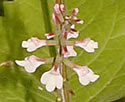Phryma leptostachya (American Lopseed)
| Also known as: | |
|---|---|
| Genus: | Phryma |
| Family: | Phrymaceae (Lopseed) |
| Life cycle: | perennial |
| Origin: | native |
| Habitat: | part shade, shade; moist woods, thickets |
| Bloom season: | June - August |
| Plant height: | 1 to 3 feet |
| Wetland Indicator Status: | GP: FACU MW: UPL NCNE: FACU |
| MN county distribution (click map to enlarge): |  |
| National distribution (click map to enlarge): |  |
Pick an image for a larger view. See the glossary for icon descriptions.
Detailed Information
Flower: 


![[photo of flowers]](/udata/r9ndp23q/pink/american-lopseed_0712_120246-t.jpg) Flowers are oppositely attached in spikes that arise from the leaf axils near the top of the plant, and at the top of the main stem. Individual flowers are about ¼ long and wide, tubular, with 1 short notched top lobe that turns up and 3 longer bottom lobes that extend out. The top lobe is pink-tinged with a dark pink streak along the top outside, the bottom lobes are pale pink to white. There are 4 yellow-tipped stamens inside the tube.
Flowers are oppositely attached in spikes that arise from the leaf axils near the top of the plant, and at the top of the main stem. Individual flowers are about ¼ long and wide, tubular, with 1 short notched top lobe that turns up and 3 longer bottom lobes that extend out. The top lobe is pink-tinged with a dark pink streak along the top outside, the bottom lobes are pale pink to white. There are 4 yellow-tipped stamens inside the tube.
Leaves and stem: 

![[photo of leaves]](/udata/r9ndp23q/pink/american-lopseed_0712_121413-t.jpg) Leaves are roughly egg-shaped, to 6 inches long and 4 inches wide, coarsely toothed, softly hairy, with a pointed tip and tapering abruptly or rounded at the base. Leaves at the top of the plant are smallest, near the base of the plant are broadest and have longer stalks than at the top. Attachment is opposite, with each pair at right angles to the pair below. The main stem is angled and hairy.
Leaves are roughly egg-shaped, to 6 inches long and 4 inches wide, coarsely toothed, softly hairy, with a pointed tip and tapering abruptly or rounded at the base. Leaves at the top of the plant are smallest, near the base of the plant are broadest and have longer stalks than at the top. Attachment is opposite, with each pair at right angles to the pair below. The main stem is angled and hairy.
Fruit: 
![[photo of fruit]](/udata/r9ndp23q/pink/american-lopseed_0726_144625-t.jpg) Fruit is a seed that hangs down close to the stem.
Fruit is a seed that hangs down close to the stem.
Notes:
American Lopseed and Pointed-leaf Tick-trefoil both have pink spikes and grow in the woods at the same time, sometimes right next to each other. The leaves of Pointed-leaf Tick-trefoil are compound and toothless, and its flowers have a broad, round upper lip. At one time Phryma was in family Phrymaceae (Lopseed), then it was moved to Verbenaceae (Verbena), now it's back in Phrymaceae.
Native Plant Nurseries, Restoration and Landscaping Services ↓
More photos
Photos taken at Long Lake Regional Park, New Brighton, MN July 2008
Comments
Have you seen this plant in Minnesota, or have any other comments about it?
on: 2010-07-10 21:34:17
I saw a nice Pointed-leaf Tick-trefoil on the trail just off the southwest corner of Vista Hills Park. Another 100 feet farther and, sure enough, one of these. So very similar, but so surprisingly different!
on: 2014-07-10 20:41:23
American Lopseed. Found growing naturally in wooded area.
on: 2015-08-05 16:57:13
I have a lot of this in my native garden. I consider it invasive. Anybody else care to comment?
on: 2015-08-05 17:56:28
Deb, I think "invasive" is not the correct word. I have never seen big colonies of this plant in its native habitat, only scattered plants here and there. In a cultivated setting many native plants will be more robust or opportunistic or "aggressive" than in a natural setting with natural soil/moisture conditions and natural competition. If you don't want to manage it, pull it out.
on: 2016-07-04 12:36:48
Have seen many of these around the edges of our yard for the last few years. They are now blooming.
on: 2018-07-07 13:28:11
My comment above was a mistake. Too me, the flowers of A. Lopseed and P.-leaf T. trefoil and almost identical. But the leaf is obviously different. Jagged, large eliptical vs. pointed sweetheart shape. I have both growing on my hill, which becomes very dense with vegetation in the summer, so was not comparing leaves at the time. Thanks, MN Wildflowers!
on: 2020-07-13 18:19:48
Just confirmed I have 1 plant on my wooded lot. Initially thought it might be tick trefoil which I cherish, but realized it was something else. Used PlantID app to verify.
on: 2020-07-29 09:50:36
I have American Lopseed, but also a similar plant that I can't identify. Tiny white flowers, similar leaf petals but minimal scalloping of leaves. Opposite attachment at right angles, blooms at same time. Could not find in the search.
on: 2020-07-29 14:27:11
Luciearl, a picture says 1000 words :-) Post a photo on the Minnesota Wildflowers Facebook page.







 American Lopseed plant, about 2 feet tall
American Lopseed plant, about 2 feet tall